High Power: Film Review
Published on April, 02 2014
by Edith Bell, WILPF-US Pittsburgh Branch
Pradeep Indulkar, a nuclear engineer from India, showed his award winning documentary "High Power" at Carnegie Mellon University (CMU) in Pittsburgh on March 3 on his tour through the US.
The event was sponsored by the local group Remembering Hiroshima/ Imagining Peace and WILPF.
"High Power" is set in the village of Tarapur, India, where a power plant was built. It tells the story of following betrayal and slow destruction of the health and livelihood of the 10,000 people who lived there.
Begun in 1969, the project promised jobs and services, none of which materialized. The film interviews many residents about the negative physical consequences they have endured due to radiation exposure, including miscarriages , kidney disorders, high blood pressure, heart problems, low IQs of children, and how the environment has changed (i.e. deformed coconut trees which do not grow to their full height). Dr. Sonia Sarve reported about the serious infertility issues she observed. The hot water discharge by the nuclear plant warms the temperature of the ocean killing the fish in the area. Fishing was the main trade of the village, the fish that are left now are unmarketable.
Nuclear power is currently 3% of the energy used in India and expected to increase to 20% by 2020. In 2009 there were protests and in 2011 Fukushima became another focal point to rally. Because India has 8 months of bright sunshine, one may think solar is a feasible option but the government does not support it. Pradeep says financial interests control the energy mix. Westinghouse was mentioned many times as one of the companies who have built power plants in India. There is a huge nuclear power plant currently being planned for the West Coast India.
The film has won the Yellow Oscar in the short film category in the Rio de Janeiro leg of the Uranium Film Festival.



